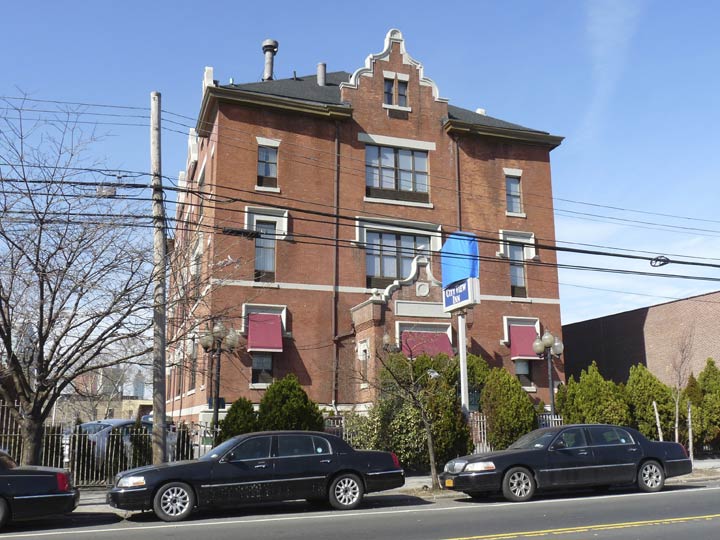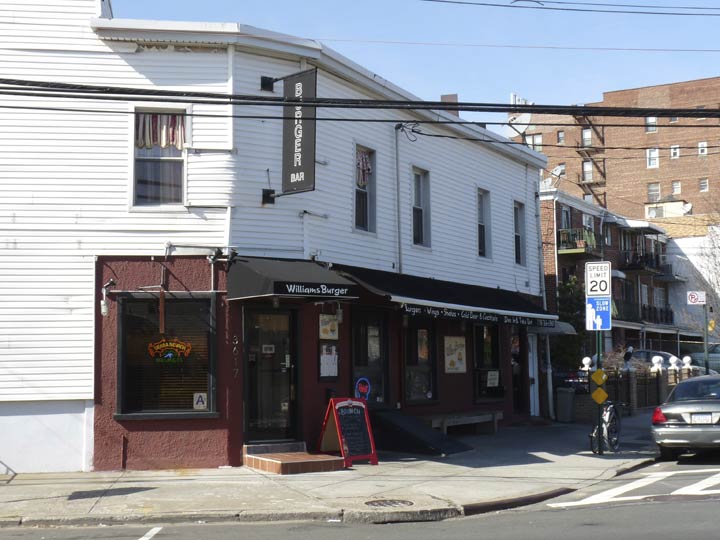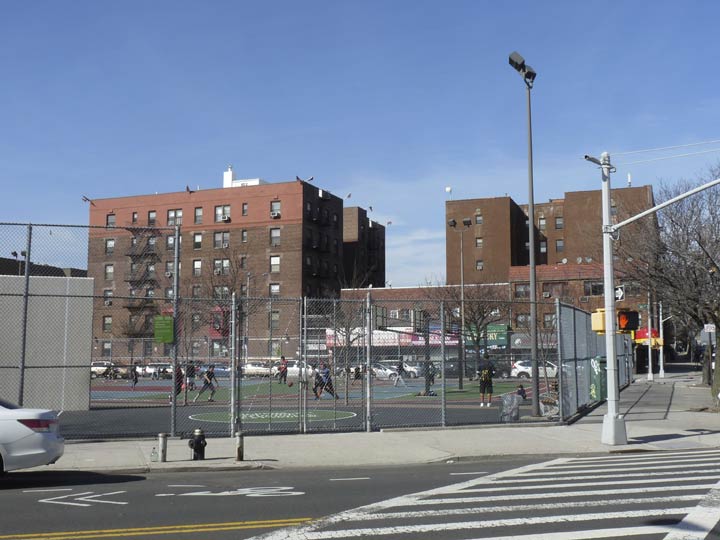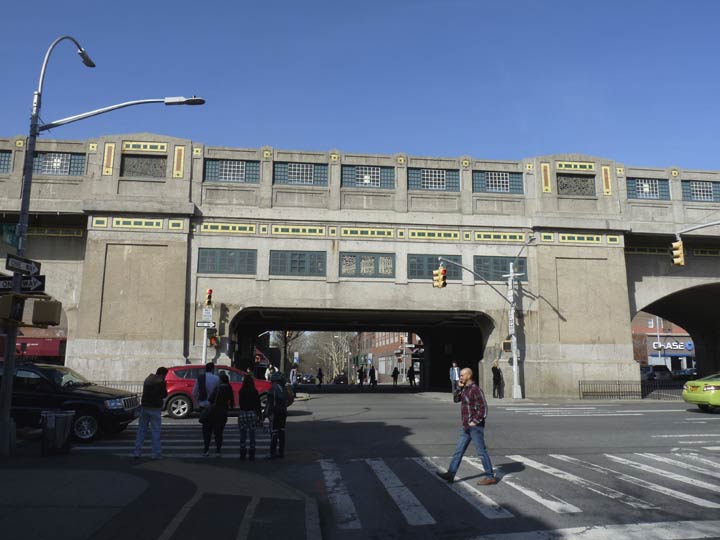For this trip, I transferred from the J train to the 7 train. The two lines do not have a transfer point at any station — so I had to walk seven or eight miles to make the transfer. After a few weeks trampling about southern and western Staten Island, visiting Prince’s Bay, Travis and Charleston, I was in the mood to travel through more urban scenes and starting in Williamsburg, which has been built up for over a century and a half, fit the bill pretty well. I decided to travel through the Willie, into Greenpoint’s eastern reaches, and then cross the noxious and noisome Newtown Creek into Sunnyside.
GOOGLE MAP: WILLIAMSBURG TO SUNNYSIDE
At the conclusion of Part 4, I had indeed crossed Newtown Creek, which forms part of the undefended border of Brooklyn and Queens. Thus far there are no barriers of any kind between any adjoining pair of NYC borough, though only Brooklyn and Queens share a substantial land border (there is also a very short one between Manhattan and the Bronx). There are, however tolls and transit fares to be bourne when transit is desired between Manhattan and Queens, Bronx, or Staten Island (the ferry is free, but the Verrazano Bridge costs $15 one-way).
On foot, however, until further notice, it is perfectly acceptable to cross between boroughs with absolutely no cash charge or pat-down from overeager governmental officials, and no doubt contraband passes between Brooklyn and Queens hundreds or thousands of times daily, as well as furtive, dark-clad individuals with cameras.

The Greenpoint Avenue (J.J. Byrne) Bridge passes over Long Island Rail Road tracks belonging to the so-called Montauk Branch, extending from Long Island City to Jamaica and beyond. Exclusively used for freight these days, these tracks actually carried passenger service until 1998, utilizing ancient, rattling MP-50 cars built in the 1950s and pulled by a diesel engine. I was happy to grab one of the last passenger trains in regular service that stopped at all the rudimentary stations such as the ones at Haberman, Fresh Pond Road and Glendale, which consisted mainly of slight clearings by the tracks.

Just past the Byrne Bridge in Queens, Greenpoint Avenue forks in two, continuing into Sunnyside under its original name, and branching into Van Dam Street (left), which runs north to Queens Boulevard just east of Sunnyside Yards and Queens Plaza. In 2016, skyscrapers were springing up in the Plaza, while the de Blasio administration has expressed hopes of decking over the massive Sunnyside Yards and adding thousands of apartment buildings to an already overtaxed Queens infrastructure.
I have now arrived in a small, ever-shrinking enclave known as Blissville, a small triangle defined by the Queens-Midtown Expressway, the Montauk Branch of the LIRR paralleling Newtown Creek, and Calvary Cemetery. (I’ve occasionally included West Maspeth, which is east of the cemetery and the Brooklyn-Queens Expressway, in my descriptions of Blissville, as well). The small community is named for its founder, Neziah Bliss, inventor, shipbuilder and industrialist who owned most of the land in the 1830s and 1840s. Bliss, a protégé of Robert Fulton, was an early steamboat pioneer and owned companies in Philadelphia and Cincinnati. Settling in Manhattan in 1827, his Novelty Iron Works supplied steamboat engines for area vessels. By 1832 he had acquired acreage on both sides of Newtown Creek, in Greenpoint and what would become the southern edge of Long Island City. Bliss laid out streets in Greenpoint to facilitate the riverside shipbuilding concern and built a turnpike connecting it with Astoria; he also instituted ferry service with Manhattan. Though most of Bliss’ activities were in Greenpoint, he is remembered chiefly by Blissville and by a stop on the Flushing Line subway (#7) that bears his family name; 46th Street was originally known as Bliss Street.
Here are a number of modest brick walkups I’ve already described as “Brooklyn vernacular” in an earlier segment of this series, and western Queens in some spots quite resembles Brooklyn.

Bantry Bay Tavern, Greenpoint Avenue and Bradley Avenue, and the County Cork Association speak of a tenuous Irish presence in Blissville, which is actually larger in neighboring Sunnyside. Irish immigration to the USA has ebbed and flowed in response to Ireland’s economy, way up in the 1990s but way down now. The Cork Association was founded to help immigrants from County Cork as well as Irish immigrants as a whole:
The County Corkmen’s Benevolent, Patriotic and Protective (B, P & P) Association was founded in 1884. The purpose of forming the Association was to promote unity, good will and protection amongst its members and to foster their culture and traditions. A fund was established to aid the sick and disabled members and to assist in payment of funeral benefits. [NY Cork Association]

Looking northwest on Bradley Avenue toward Queens Plaza and its increasing collection of megaliths.
The street plan of Blissville has remained intact, with Bradley, Starr and Gale Avenues running athwart the overall north-south grid, and 34th and 35th Streets (formerly Young and Pearsall Streets) aligning perpendicularly.

One of the most magnificent (former) public schools in Queens, the Flemish-design PS 80, now the City View Inn. Constructed around the beginning of the 20th Century, this was a school for only about 30 years. It later became a yeshiva, but stood vacant for a few decades until an investor unsuccessfully attempted to operate a hotel, In the 1980s, new owner Mohammed Daoud partnered with the Best Western motel chain, making it possibly the best-looking Best Western in North America. Of late, the City View is still going strong, but the Best Western connection has seemingly been severed.

In the early 19th Century, Queens had dozens of tiny burial grounds scattered around, many dating to the mid-1600s. In 1847 the Rural Cemetery Act was passed, prohibiting any new burial grounds from being established on the island of Manhattan. Presciently anticipating the legislation, trustees of the old St. Patrick’s Cathedral on Mulberry Street in what is today known as Little Italy began buying up property in western Queens. Calvary Cemetery, named for the hill where Christ was crucified, opened in 1848. The original acreage had been nearly filled by the late 1860s, so additional surrounding acreage was later purchased to the east.
Much more on Calvary Cemetery, where all roads lead, according to Mitch Waxman, master of the Newtown Pentacle.

Among the many charms of Calvary is the gatehouse/office at Greenpoint and Gale Avenues at the Gate of St. Calixtus. The brick Queen Anne building with a distinctive hexagonal, peaked tower was constructed in 1892.
Calixtus, or Callistus I, was an early pope (217-222) and was martyred (allegedly by being thrown down a well) by the Roman Empire for his beliefs. His predecessor, Pope Zephyrinus, entrusted to him the care of the burial vaults along the Appian Way where many popes during the 3rd century were interred, as rediscovered in an archeological expedition in 1849. He is the patron saint of cemetery workers.
The magnificent St. Raphael Catholic Church at Greenpoint Avenue at the Queens Midtown Expressway can be seen from most points in southwest Queens and Sunnyside, as the high-spired church sits on a promontory adjoining Calvary Cemetery.
The parish of St. Raphael was established in 1865, and the first Mass was said in November 1868 by Rev. Theodore Goetz, who attended the parish from Winfield, a former neighborhood adjoining Woodside.
Built of brick and sandstone, the church is 149 feet long, 69 feet wide, and the height of the steeple is 150 feet. It is believed that the Gothic-style church was designed by Patrick Keely, the famed architect of mostly Catholic churches in the 19th Century.
On a sad note, St. Raphael’s elementary school was forced to close in June 2012 because of declining enrollment and rising costs.
Raphael, one of seven archangels in Judaeo-Christian tradition, is the patron saint of travelers, the blind, bodily ills, happy meetings, nurses, physicians and medical workers. He is often pictured holding a staff and either holding or standing on a fish. His feast day is celebrated on September 29, along with St. Michael and St. Gabriel, according to Catholic Online.
Looking west from the Queens Midtown Expressway toward the “shining city.” This is an especially difficult pedestrian crossing, as right-turning cars often thwart walkers from crossing. Scurrying like a rodent is the generally most effective means of transit.

The Williams Burger, Greenpoint and 37th. This isn’t the only geographic displacement we’ll see.
We’re now in Sunnyside, defined by the Sunnyside Railyards used by the LIRR, Amtrak and New Jersey Transit on the north and west; the Queens Midtown Expressway on the southl and Woodside Avenue and 58th Street on the east. The French Huguenot Bragaw family settled the area in the early 18th Century, calling their tract “Sunnyside Hill,” and the Sunnyside Hotel opened in the 1840s, serving as a roadhouse for travelers heading west to New York City.
The method can be unreliable, but I’ve sometimes gauged the age of a neighborhood by how many small, one family dwellings you can find, as well as two-story frame buildings. These two on Greenpoint Avenue and on 38th Street give every indication of having been here a century or more.

Sunnyside is more park-starved than most Queens neighborhoods, enough so that the PS199Q Community Playground at Greenpoint Avenue and 40th Street is open to the public during non-school hours.
At Greenpoint Ave. and 48th Avenue, two adjoining shops, the De-Light Deli and Greenpoint Pharmacy, give evidence of much-earlier signage. The pharmacy is named for the avenue on which it sits, not the neighborhood.

Edging now into Sunnyside’s true downtown, on Greenpoint Avenue between 40th Street and 48th, where it meets Queens Boulevard and continues east with a name change to Roosevelt Avenue.

The largest public park in Sunnyside is the Lance Corporal Thomas P. Noonan Playground, bounded by Greenpoint Avenue and 43rd Street. Noonan was posthumously awarded the Congressional Medal of Honor for his heroism during the Vietnam War. The playground was formerly known as Thomson Hill Park. (In Sunnyside Gardens, there is a private park that is somewhat larger.)

If you asked 10 random New Yorkers what neighborhood the Greenpoint Lounge is in, they would have a predictable response; but the lounge, at 43-22 Greenpoint Avenue, is ensconced firmly in Sunnyside.

Handsome Tudor apartment at the crossroads of Greenpoint Avenue at 47th Avenue and 44th Street.

The Egyptian-style Bliss Theatre is actually located on 45th Street, which was once known as Packard Street (46th, one block to the east, was once Bliss Street). The ever-reliable Cinematreasures:
The Bliss Theatre first opened on December 27, 1930 and was built by Century Theaters with its usual architect-designer team of R. Thomas Short & William Rau. By that time, the sound era was well underway, so the Bliss Theatre was designed solely for movies, with a stage just deep enough for the hanging of a Magnascopic Screen that could be enlarged for special effects from the projection booth.
The Bliss Theatre’s interior decor was a modern interpretation of motifs found in ancient Egyptian architecture. Boldly-colored murals on the side walls and above the proscenium arch depicted scenes from Egyptian history. Located in the heart of the Sunnyside shopping district, the Bliss Theatre was never more than a subsequent-run neighborhood house until the 1960’s when movie distribution switched to city-wide Premiere Showcase openings. But the change didn’t increase attendance at the Bliss Theatre, and Century decided to close it due to its high operating costs.
The building was sold to Jehovah’s Witnesses, which converted it into a church with almost no changes to the exterior. The interior, however, has been extensively renovated, although an atmospheric lobby remains but with new paintings on the walls. The new owners removed everything of the Egyptian decor that showed nudity and/or pagan symbolism. The result now is an auditorium that looks like it was built yesterday…

The Sunnyside Arch, a beloved kitsch neighborhood symbol, was installed by a long-gone community group in 1983 on 46th Street and Queens Boulevard and given a $500K (!) makeover in 2009.

Another neighborhood institution, the concrete Queens Boulevard elevated viaduct, was built in 1917 before Sunnyside was fully populated; early photos show it running through empty fields on either side of Thomson Avenue, since become part of Queens Blvd.

Before kicking it in the head I was finally able to transfer to the #7 train after getting off the J train in Williamsburg! At this distance, though, it’s a double fare.
In 1999, Yumi Heo, a children’s book artist by trade, was commissioned to design about 30 windows in the 33rd, 40th and 46th Street stations. They consist of 26 cultural or historic scenes corresponding to the letters A through Z, along with a couple of generic scenes (subway cars, etc). A letter standing for the scenes or items shown in the glass panel also be found, but there is no other explanation as to what is being shown. The viewer, hopefully, will be prompted to look at the scene and its corresponding initial and figure out what scene in Queens is being depicted. For example, the “A” panel at 33rd Street shows three horses and jockeys rounding a racetrack curve, and a fellow blowing a trumpet on the right panel. The inferred subject is Aqueduct Racetrack on Ozone Park. The “B” panel shows ornamental plants and a gazebo: The Queens Botanical Garden.
However, the “T” panel stumps me! Any ideas? Send them to kevinjudewalsh@gmail.com.
6/12/16

